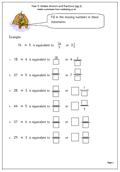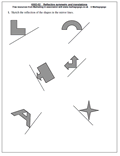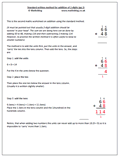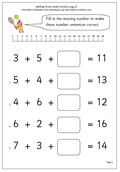 Only six questions on this worksheet, but plenty of important concepts. Firstly, that division can be represented as a fraction, and, of course, a fraction can be thought of as a division.
Only six questions on this worksheet, but plenty of important concepts. Firstly, that division can be represented as a fraction, and, of course, a fraction can be thought of as a division.
Secondly, an improper fraction (where the top number is larger than the bottom number) can be shown as a mixed number (a whole number and a proper fraction). This can be done by dividing the numerator (top number) by the denominator (bottom number) to find the whole part with the remainder being the numerator of the new fraction. The denominator remains the same.


